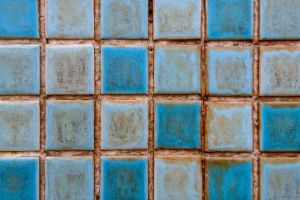
Mold on pool tiles is a common issue that many Las Vegas, NV, homeowners face, often leading to stubborn stains and slippery surfaces. Understanding both the causes and solutions is key to maintaining a healthy swimming environment. Oasis Pool Maintenance, LLC can help identify and eliminate the source of mold on your pool tiles, ensuring a cleaner, safer swimming environment.
What Causes Mold On Pool Tiles?
Mold growth on pool tiles is primarily driven by a combination of moisture, warmth, and organic material. Las Vegas’s hot climate, combined with frequent water use, makes pools a perfect breeding ground for mold. Recognizing these causes is the first step toward effective mold removal and prevention. That’s where consistent pool tile cleaning in Las Vegas becomes essential for long-term protection.
- Humidity: Even in desert environments like Las Vegas, pools introduce localized areas of high humidity conducive to mold growth.
- Poor Ventilation: Enclosed swimming pool areas without proper airflow can trap moisture, encouraging mold to form.
- Lack Of Regular Maintenance: Infrequent cleaning or inadequate maintenance of pool surfaces allows mold to establish itself.
- Organic Debris: Leaves, dirt, and other organic matter provide nutrients for mold if they accumulate on tiles.
- Grout Lines: Mold often begins forming in the porous grout between tiles, where moisture lingers and cleaning is often overlooked.
Is it Mold Or Algae?
Determining whether you’re dealing with mold or algae in your pool can be challenging, yet it’s essential for maintaining a healthy swimming environment. Mold and algae may appear similar, but addressing them requires different approaches. If you’re not sure, contact a skilled pool technician to help you identify and eliminate the issue.
- Visual Differences: Algae looks like green, yellow, or black slime; mold appears as dark spots, often on tiles or equipment.
- Causes: Algae thrives in poor water chemistry; mold forms in damp, poorly ventilated areas.
- Treatment: Algae requires pool shock and brushing; mold needs tile cleaning and better ventilation.
Steps To Get Rid Of Mold On Your Pool Tiles
Removing mold from pool tiles is essential to maintain both aesthetic appeal and safety. When left untreated, mold can not only lead to unsightly stains but also create slippery surfaces that pose a hazard. Consistent pool cleaning is critical to stop mold from becoming a recurring issue.
- Power Washing: Using a pressure washer can effectively remove mold and mildew from tiles. Consider professional help when using pressure washers to avoid tile or grout damage.
- Cleaning Solutions: Apply an eco-friendly mixture of baking soda and water for mild cases, or use diluted chlorine bleach for more stubborn mold.
- Scrubbing: Use a scrub brush with non-abrasive bristles to avoid scratching the tiles while removing mold.
- Rinsing Thoroughly: After cleaning, ensure thorough rinsing of the tiles to remove any chemical residues that could affect pool water chemistry.
Proactive Mold Prevention For Pool Maintenance
Prevention is the most effective approach to deal with mold on swimming pool tiles. By integrating preventive measures into your regular pool maintenance routine, you can significantly reduce the risk of mold growth. Implementing these steps can help maintain a healthy pool environment and enhance the longevity of your pool tiles.
- Regular Maintenance: Schedule consistent pool cleaning sessions to prevent the accumulation of dirt and organic debris.
- Water Circulation: Ensure pool water is always circulating to deter mold-friendly stagnant conditions.
- Use Pool Covers: Properly covering the pool when not in use can reduce water evaporation and help control humidity levels.
- Optimize Ventilation: If applicable, improve airflow in enclosed pool areas to reduce moisture build-up.
When To Call A Professional Pool Maintenance Service
Although DIY methods can be effective for minor mold issues, there are situations where it is advisable to seek out professional help for mold removal. Professional services not only ensure effective mold removal but also offer options for long-term maintenance strategies.
- Persistent Mold: If mold returns frequently despite your best efforts at cleaning and prevention, professionals can identify and address underlying issues.
- Severe Infestations: Large or widespread mold problems may require specialized equipment and expertise to resolve fully.
- Tile Damage: During mold removal, if you notice damage to pool tiles or grout, a professional can provide repairs and advice on preventing further deterioration.
Frequently Asked Questions About Mold on Pool Tiles
Addressing common queries can provide clarity and further help Las Vegas homeowners manage and prevent mold issues effectively.
Can I Prevent Mold Just By Adjusting Pool Chemicals?
Correct pool chemistry is crucial, but alone won't prevent mold spots; cleaning and proper ventilation are also necessary.
How Can I Tell If It's Truly Mold?
Mold often appears as black or green patches on tiles; if unsure, a professional assessment can confirm the presence of mold.
Is Mold Harmful To Swim In?
While small amounts of mold might not pose immediate health risks, it can harbor harmful bacteria or make surfaces slippery, increasing accident risks.
Trust Oasis Pool Maintenance For A Pristine Pool
For homeowners in Las Vegas seeking a partner for expert pool care, Oasis Pool Maintenance is dedicated to ensuring your pool remains a clean and enjoyable retreat. We offer reliable and efficient mold removal, tile cleaning, and pool care services backed by a commitment to customer satisfaction. Let us help keep your pool tiles mold-free and your pool experience undisturbed. Contact us today to explore how our professional services can benefit you.
